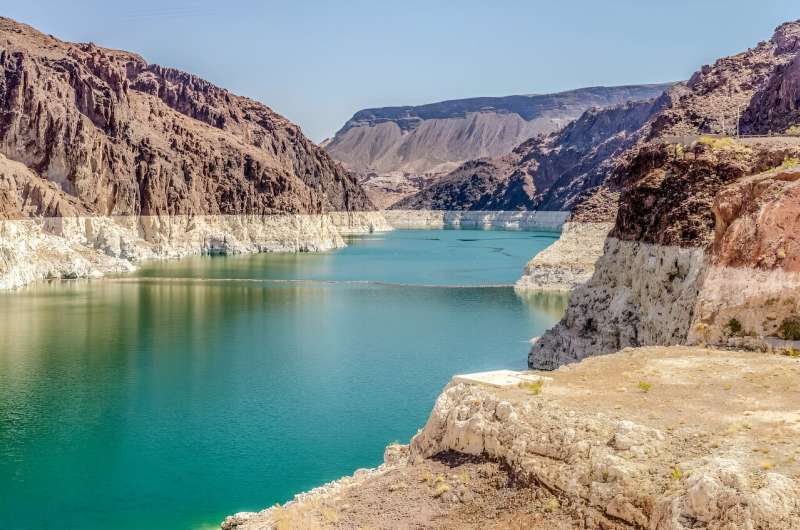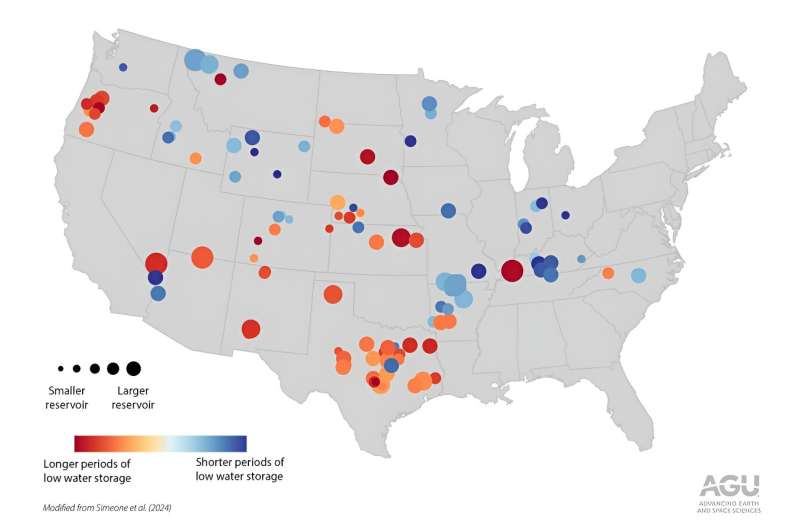This article has been reviewed according to Science X's editorial process and policies. Editors have highlighted the following attributes while ensuring the content's credibility:
fact-checked
peer-reviewed publication
trusted source
proofread
US water reservoirs are shrinking and becoming less reliable, new study finds

Major water reservoirs across the continental United States are experiencing longer, more severe, and more variable periods of low storage than several decades ago, a new study reports. The problems are most severe in the western and central United States, but reservoirs in the eastern and southeastern United States are not immune, the study finds. Overall, reservoirs are less reliable and more vulnerable to climate change than they used to be.
The findings, which update critical information about water storage, should improve water forecasting, helping water managers at national, regional and local levels make more informed decisions about the timing and volume of water release. The study appears in Geophysical Research Letters.
Water storage reservoirs are becoming increasingly important as more ephemeral, natural storage grows less reliable: In many regions, snowpack is diminishing, rivers are running low, and humans are pumping away groundwater reserves.
Reservoirs can help limit the downstream propagation of drought, but interruptions to their normal operation can cause widespread water availability problems. Take, for example, the low storage in Lakes Mead and Powell from 2000 to 2021—the region's driest 22-year period in 1,200 years. That drought triggered widespread water-use restrictions across the southwestern United States.
Drought, water withdrawals, and sediment buildup behind dams determine how much water can be stored in a reservoir. Each of those factors has been changing, in many cases pushing reservoirs away from the conditions under which they were designed to operate.
"Reservoirs are a key component of the modern water cycle, and they're a part that water managers can influence," said Caelan Simeone, a hydrologist at the U.S. Geological Survey's Oregon Water Science Center who led the study. "We know that reservoirs are changing, and that reservoirs were designed for historical water conditions. So now there's uncertainty about how or whether reservoirs will be able to adapt."

National water snapshot
Much information and research on reservoirs is local or regional, limiting scientists' understanding of how climate and anthropogenic changes are impacting water storage on a national scale.
"Water reservoir managers could benefit from having that knowledge," Simeone said. "It would enable them to consider larger, national trends in water as well as more local patterns."
To get a countrywide perspective on how reservoirs are changing, Simeone and colleagues analyzed water levels in 250 large reservoirs from 1981 to 2020, looking for changes in baseline, maximum, and minimum water levels. They compared water levels to management practices and climate, looking for patterns that could explain any changes in water level. Reservoir data for the U.S. Northeast was not available, so that region is excluded from the study.
Reservoirs in more arid western and central United States tended to have longer, more severe, and more variable periods of low storage. That's partially to be expected, as reservoirs in drier regions are expected and designed to handle variable annual runoff and drought conditions. But drought conditions today push low-flow conditions to the extreme.
It's not just a problem for the arid West. Reservoirs in the wetter Southeast and Pacific Northwest, as well as the arid regions, saw a drop in the annual maximum storage. Out of 250 reservoirs studied, 169 had declining maximum storage, and 89 of those saw significant drops. Across all reservoirs, the median decline in maximum water storage relative to the mean was 2.2%; for reservoirs with significant declines, the median decrease was 8.1%.
Simeone did not expect those drops.
"The reduction of maximum annual storage was widespread, which really surprised us," Simeone said. "Many reservoirs just aren't filling to the levels they once did. Overall, we're getting this picture of declining maximum water levels across the United States. This was the case even in places that were not seeing more low storage periods."
A combination of increased sediment and changing hydroclimatic conditions are likely driving the observed increase in variability of water storage and overall decreases in water levels, Simeone found.
Reservoir managers try to adapt to those changing conditions, which can be difficult when reservoirs were designed decades ago, under the assumption that climate and society would be relatively similar. (Most reservoirs and dams in the study were built between roughly 1930 and 1970.)
"There was an assumption that conditions would be more or less stationary," Simeone said. "Climate change interrupted that. Now, managers need to try to mitigate the hydrologic shifts we're seeing."
More information: Caelan E. Simeone et al, Declining Reservoir Reliability and Increasing Reservoir Vulnerability: Long-Term Observations Reveal Longer and More Severe Periods of Low Reservoir Storage for Major United States Reservoirs, Geophysical Research Letters (2024). DOI: 10.1029/2024GL109476. agupubs.onlinelibrary.wiley.co … 10.1029/2024GL109476
Journal information: Geophysical Research Letters
Provided by American Geophysical Union




















